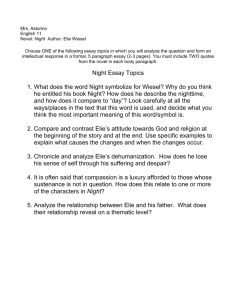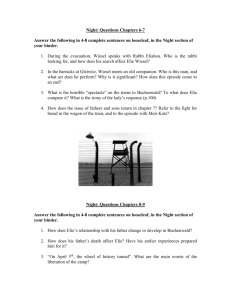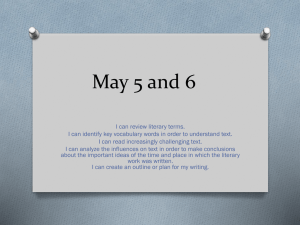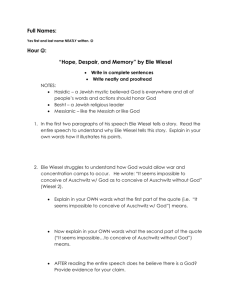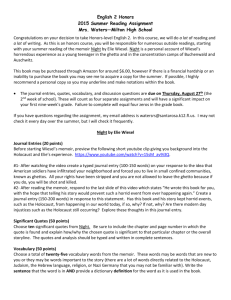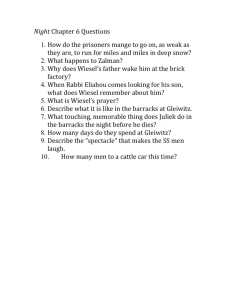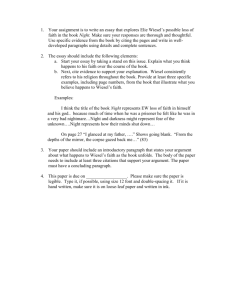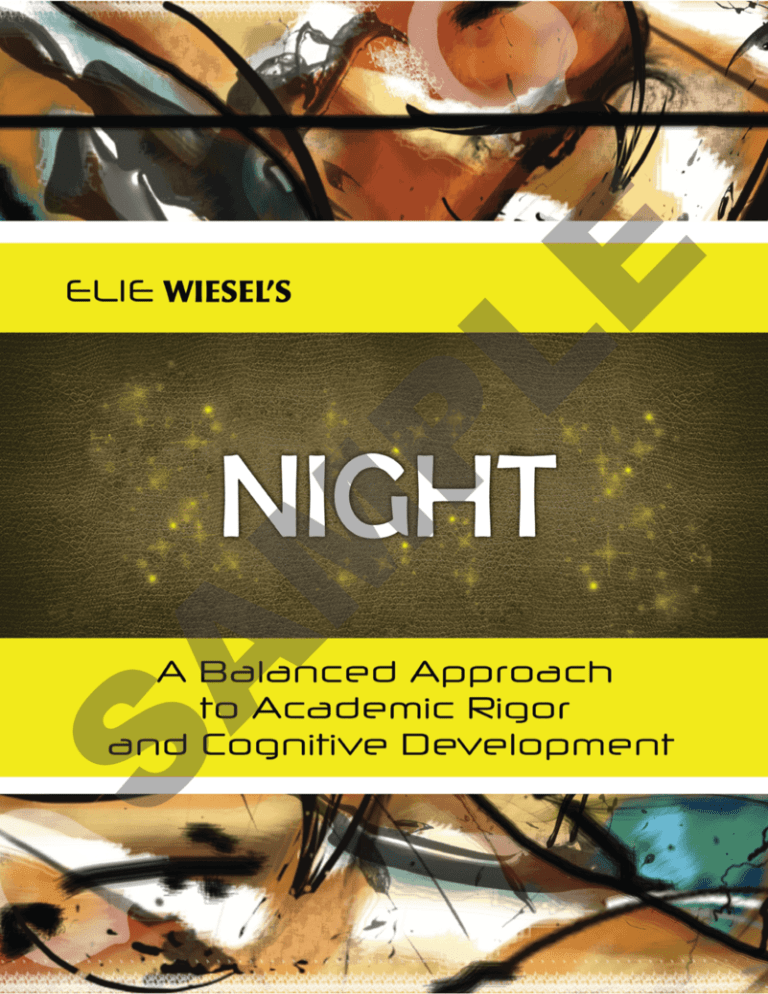
S
LE
M
P
A
LE
Elie Wiesel’s
Night
S
A
M
P
A Skills-Based
Approach to
Teaching the Novel
Houston, Texas
501-1256
S
LE
M
P
A
Elie Wiesel’s Night: A Skills-Based Approach ot Teaching the Novel
About the Region 4 Education Service Center
LE
The Region 4 Education Service Center (Region 4) supports student achievement
by providing educational products and services that focus on Excellence, Service,
and Children. We create and conduct professional development institutes, produce
research-based instructional materials, and provide technical assistance to strengthen
educational systems to promote the academic success of all students.
Elie Wiesel’s Night: A Skills-Based Approach to Teaching the Novel
Copyright © 2008
Region 4 Education Service Center
7145 West Tidwell
Houston, Texas 77092-2096
M
P
All rights reserved. No part of this book may be kept in an information storage or
retrieval system, transmitted, or reproduced in any form or by any means without the
prior written permission from Region 4.
The individual purchaser is hereby granted permission to reproduce all Masters and
Appendices for classroom use only. Reproduction of any part of this book for other
teachers, entire schools, or school systems is strictly prohibited.
S
A
ISBN 978-1-933521-23-7
Please visit our Web site www.region4store.com to view our online catalog and to
purchase Region 4 products using a credit card or purchase order.
iii
Elie Wiesel’s Night: A Skills-Based Approach ot Teaching the Novel
Additional Region 4
Reading/Language Arts Resources
yy
yy
yy
LE
S
A
yy
TAKS Accelerated Curriculum for Reading, (Grades 3–5, English; Grade 5, Spanish)
TAKS Accelerated Curriculum for Reading, Middle School (Volumes I, II, and III)
TAKS Reading Preparation Series: Grade 3 through Grade 11 Exit
Reading Kit for Struggling Students
Spelling Kit for Struggling Students
Alphabet Kit for Struggling Students
Preparing Struggling Secondary Students for Writing Assessments
Teaching Writing in Grades 3–11: Books One, Two, and Three
TAKS Open-Ended Response Guide Grades 9–11 Exit, Second Edition
Targeted Reading Intervention for First Grade
Finding the Writer in Your Secondary English Language Learners
Teaching Your Secondary English Language Learners the Academic Language of Tests
Vocabulary Instruction for Intermediate English Language Learners
Managing Instructional Groups in Prekindergarten and Kindergarten Classrooms
Prekindergarten Manuals and Manipulative Kits: Letter Knowledge & Early Word Recognition; Phonological Awareness; Written Expression; Developing Knowledge of Literary
Forms; Verbal Expression; Print and Book Awareness
Teaching Writing in Kindergarten
Teaching Writing in First and Second Grades
Primary Reading Instruction Manuals for Educators (PRIME): Phonemic Awareness Instruction; Phonics Instruction; Vocabulary Development Instruction; Fluency Instruction; Comprehension Instruction
Small-Group Instruction Tools for First- and Second-Grade Teachers
M
P
yy
yy
yy
yy
yy
yy
yy
yy
yy
yy
yy
yy
yy
yy
yy
Go to www.region4store.com to view other products and services provided by
Region 4 and to order online.
iv
Elie Wiesel’s Night: A Skills-Based Approach ot Teaching the Novel
Acknowledgements
Region 4 would like to thank the following individuals for the development of the
Elie Wiesel’s Night: A Skills-Based Approach to Teaching the Novel:
Region 4 Reading/Language Arts Services Staff
LE
Heather Lord & Billy E. Sanders
Graphic Design
Connie Abshire
Education Specialist
M
P
Sonja Hollan
S
A
Director,
Reading/Language Arts Services
v
Elie Wiesel’s Night: A Skills-Based Approach ot Teaching the Novel
Table of Contents
Overview...................................................................................................................... 1
Why Use a Skills-Based Approach? .......................................................................... 2
How to Use this Manual.............................................................................................. 3
LE
Teaching Notes (pp. 5–10).......................................................................................... 5
Pacing Instructions...................................................................................................... 7
Possible Section Combinations.................................................................................. 8
Vocabulary by Sections............................................................................................... 9
People to Remember................................................................................................ 10
Teaching Suggestions................................................................................................11
M
P
Section 1 (pp. 3–22)................................................................................................... 13
Student Discussion Topics........................................................................................ 14
Answer Key for Discussion Topics............................................................................ 16
Vocabulary Activities................................................................................................. 24
Quizzes for Section 1................................................................................................ 34
Answer Keys for Quizzes.......................................................................................... 36
Section 2 (pp. 23–46)................................................................................................. 41
Student Discussion Topics........................................................................................ 42
Answer Key for Discussion Topics............................................................................ 44
Vocabulary Activities................................................................................................. 51
Quizzes for Section 2................................................................................................ 60
Answer Keys for Quizzes.......................................................................................... 62
A
Section 3 (pp. 47–65)................................................................................................. 65
Student Discussion Topics........................................................................................ 66
Answer Key for Discussion Topics............................................................................ 68
Vocabulary Activities................................................................................................. 76
Quizzes for Section 3................................................................................................ 85
Answer Keys for Quizzes.......................................................................................... 87
S
Section 4 (pp. 66–84)................................................................................................. 91
Student Discussion Topics........................................................................................ 92
Answer Key for Discussion Topics............................................................................ 94
Vocabulary Activities............................................................................................... 102
Quizzes for Section 4...............................................................................................111
Answer Keys for Quizzes.........................................................................................113
Section 5 (pp. 85–103)............................................................................................. 117
Student Discussion Topics.......................................................................................118
Answer Key for Discussion Topics.......................................................................... 120
Vocabulary Activities............................................................................................... 127
vi
© Region 4 Education Service Center. All rights reserved.
Elie Wiesel’s Night: A Skills-Based Approach ot Teaching the Novel
Table of Contents
Quizzes for Section 5.............................................................................................. 137
Answer Keys for Quizzes........................................................................................ 139
LE
Section 6 (pp. 104–115)........................................................................................... 143
Student Discussion Topics...................................................................................... 144
Answer Key for Discussion Topics.......................................................................... 146
Vocabulary Activities............................................................................................... 154
Quizzes for Section 6.............................................................................................. 164
Answer Keys for Quizzes........................................................................................ 166
M
P
Final Assessment.................................................................................................... 171
Multiple Choice ...................................................................................................... 172
Answer Key for Multiple Choice.............................................................................. 180
Short Answer Questions ........................................................................................ 189
Answer Key for Short Answer Questions................................................................ 190
Essay Questions..................................................................................................... 192
Essay Question Scoring Rubric.............................................................................. 193
Appendices.............................................................................................................. 197
S
A
References............................................................................................................... 205
© Region 4 Education Service Center. All rights reserved.
vii
S
LE
M
P
A
S
LE
M
P
A
Elie Wiesel’s Night: A Skills-Based Approach ot Teaching the Novel
Answer Key
Discussion Topics
Section 3 (pp. 47–65)
Targeted Concepts,
Processes, Skills
1. Read the first paragraph on page 47. Discuss how the simile suggests yy Draw inferences
Discussion Topics
what may have happened to the former occupants of the camp.
2.
M
P
LE
Possible Response:
The simile, “The camp looked as though it had been through an
epidemic: empty and dead,” compares the actual appearance of the
camp to what the appearance might have been if most of the former
occupants had died of a deadly, contagious disease. After most
epidemics, it is customary for the bodies of those who died to be
cremated in order to prevent the spread of “the disease.” In this case,
however, the reader may conclude that the “disease” was actually the
institutionalized racial and cultural hatred that underpinned the “Final
Solution,” the systematic extermination of the Jews and all others
who did not epitomize the Aryan standard in every way. The Nazi
government did not want the Jewish culture to “contaminate” Europe,
so it systematically attempted to destroy it. It is reasonable to assume
that the former inmate residents of this camp had been sent to the
crematories.
such as conclusions,
generalizations,
and predictions and
support them from text
On page 48, discuss how Wiesel uses a physical description to
characterize the German tent leader.
the use of a simile
yy Identify and analyze
the possible
influences of the
historical context on a
literary work
yy Reference: p. 47
yy Identify and analyze
the use of diction and
allusion
yy Analyze the
characteristics and
style of text
yy Reference: p. 48
S
A
Possible Response:
Wiesel characterizes the tent leader as being a gluttonous predator.
He had “an assassin’s face,” which suggests that for him, killing was
commonplace, cold-blooded, and emotionless. Like an assassin,
death was part of his job, and this man would shed no tears over the
death of any inmates in his care. The man had hands “resembling a
“wolf’s paws.” This description alludes to an animal that is known to
be a savage predator of other animals that are smaller or weaker. His
gluttony becomes evident in his “fleshy lips” and the fact that “he could
hardly move, he was so fat.” The comment about the camp’s food
agreeing with him could be a suggestion that he was not particular
about what he ate and that he had access to all the food he desired.
Considering that food in the camps was scarce and many times used
as a reward for cruelty toward the inmates, the tent leader must have
exhibited many cruel acts in order to have been able to maintain
excess weight when all those around him were emaciated from
starvation.
yy Identify and analyze
3.
During the medical checkup, why was the dentist more conscientious
than the other doctors?
Possible Response:
The dentist was not searching for tooth decay but for dental work
made of gold.
68
yy Summarize text by
identifying main ideas
and supporting details
yy Reference: pp. 48–49
© Region 4 Education Service Center. All rights reserved.
Elie Wiesel’s Night: A Skills-Based Approach ot Teaching the Novel
Vocabulary Activities
Section 3 (pp. 47–65)
Vocabulary Word
Skills
Suggestions for Developing Skills
yy Meaning in context
yy Denotation
yy Have the class look at the dictionary definition
(denotation) of the word.
yy Predicate adjective
yy Point out that this word is used as a predicate
adjective because it modifies the noun “affection”
and it follows the linking verb “was.”
yy Latin roots
yy Point out that the word altruistic has the Latin
root alter, which means “other.”
yy Other forms of the
word
yy Other forms of the word include altruistically (adv.),
altruism (n.), and altruist (n.).
yy Synonyms
yy Synonyms for the word altruistic as it is
used in the sentence include unselfish,
selfless, compassionate, kind, publicspirited, charitable, benevolent, beneficent,
philanthropic, and humanitarian. Have students
record the word and all of its forms and synonyms
on note cards.
yy Diction / Tone
yy Discuss that the narrator is being sarcastic. The
“affection” was twisted.
S
A
M
P
(In fact, this affection
was not entirely
altruistic…)
(p. 48)
LE
altruistic
yy Ask the students to read the entire paragraph that
contains this sentence. Discuss what the meaning
of the word might be within the context of the
paragraph. Point out the clues inside the text that
would support such a meaning.
76
© Region 4 Education Service Center. All rights reserved.
S
LE
M
P
A
Elie Wiesel’s Night: A Skills-Based Approach ot Teaching the Novel
Answer Key
Multiple-Choice Quiz
Section 3 (pp. 47–65)
Questions
3.
4.
On page 51, Wiesel’s comment about Akiba
Drumer’s discoveries suggests that he no
longer—
A. respects Akiba Drumer
B. likes Akiba Drumer
C. believes in the Bible
D. believes the prediction
yy Identify and analyze tone
Wiesel uses anachrony on pages 53–54 to
explain why the French girl—
A. was Jewish
B. was Arayan
C. spoke English
D. spoke German
yy Identify and analyze the use of anachrony
yy Reference: pp. 48–49
yy Reference: p. 51
yy Reference: pp. 53–54
On pages 61–62, the description of the Polish yy Identify and analyze tone
youth’s behavior before he was executed
yy Reference: pp. 61–62
suggests that he was—
A. frightened
B. defiant
C. greedy
D. obliging
On pages 64–65, the slow strangulation of the yy Identify and analyze the use of symbolism
little pipel symbolizes the slow strangulation
yy Reference: pp. 64–65
of Wiesel’s—
A. defiance against the Germans
B. quest for liberty
C. faith in a just God
D. desire to live
S
A
5.
yy Summarizing text by identifying main ideas and
supporting details
LE
2.
Targeted Concepts, Processes, Skills
During the initial medical checkup, the dentist
was more conscientious than the doctor
because he—
A. cared about the inmates
B. was looking for decay
C. was looking for gold
D. was a German Jew
M
P
1.
© Region 4 Education Service Center. All rights reserved.
87
S
LE
M
P
A
Elie Wiesel’s Night: A Skills-Based Approach ot Teaching the Novel
Night
Final Assessment
Essay Questions
Scoring Rubric
LE
Directions: Choose one question and write a well-organized essay that responds to the question. Use
specific examples from the text to support your position.
1. Read “The Nobel Peace Prize Acceptance Speech Delivered by Elie Wiesel in Oslo
on December 10, 1986,” pages 117–120. Discuss a main implication you feel Wiesel
might want his readers to consider after reading Night. Use examples from both the
speech and the novel to support your position.
Rubric:
Student responses should take a position and clearly identify and explain what they feel to be a main
implication that Wiesel may have been making in the novel Night. Students should provide specific
examples from both the speech and from the novel that illustrate or support the identified implication.
M
P
Superior papers (90–100)
yy Identify a clear implication
yy Use specific, apt references that are used to prove a point, rather than for plot summary
yy Provides specific support, using blended or embedded quotes effectively
yy Contain specified, supported, insightful analysis
yy Are focused, never wavering from the prompt
yy Are well-argued
yy Are organized
yy Contain scholarly commentary
yy Contain upper level, but effective vocabulary and sentence structure
yy Are thorough
yy Are perceptive, persuasive, and have voice
yy Become the best papers when they have flair, depth of complexity, and apt, specific references from
both the speech and the novel
S
A
Good, solid papers (80–90)
yy Are well written, but with less maturity, less perception, and less specificity than the superior papers
yy Contain analysis, but are less thorough than the superior papers
yy Are stylistically less mature than superior papers
yy Answer the question with adequate support, but contain fewer specific references and/or specific
references that are not as effective as the references found in the superior papers
yy Reveal a more limited understanding than the superior papers
Superficial/ Base-line Papers (70–80)
yy Answer the prompt, but are formulaic, mechanical
yy Contain some analysis
yy Contain specific references from both the speech and the novel, but the references are not as
numerous or effective as those contained in the good, solid papers
yy Are simplistic
yy Are characterized by an Immature style
yy Are less organized
© Region 4 Education Service Center. All rights reserved.
193
Elie Wiesel’s Night: A Skills-Based Approach ot Teaching the Novel
Appendix IV
Specialized Vocabulary
Section 1
Hasidic (p. 3) – refers to the Hasidic or Chassidic Jews, who practice a form of Orthodox Judaism
•
Shekhinah in Exile (p. 3) – refers to a Jewish term for the divine presence
•
Kabbalah (p. 3) – refers to the study of Jewish mysticism
•
synagogue – a central place for Jewish communal worship and study; a building where an ark containing the Torah scrolls faces the ancient site of the Temple in Jerusalem
•
“destruction of the Temple” (p. 3) – refers to what traditional Judaism views as the only legitimate temple; built in Jerusalem by King Solomon circa 950 B.C.E., destroyed by Babylonian King Nebuchadnezzar circa 587/6, rebuilt 70 years later, only to be destroyed by the Romans in 70 C.E.
•
Maimonides (p. 4) – Rabbi Moses ben Maimon, who lived from 1135 to 1204 and was a major medieval rabbi, scientist, physician, philosopher, and author
•
mysticism (p. 4) – a somewhat vague term that refers to ideas and behaviors that sometimes transcend what usually is considered reasonable while searching for a definitive religious experience
•
Zohar (p. 5) – known as “Book of Splendor”; the main literary work of the Kabbalists
•
Gestapo (p. 6) – (Geheime Staatspolizei) the Nazi Secret Police headed by Himmler that was formed in 1933, became a major force in Germany by 1936, and functioned mainly to persecute Jews and dissenting political parties
•
Talmud (p. 8) – general term that refers to studies of the Jewish religion
•
Rosh Hashanah (p. 8) – the Jewish New Year that occurs in the fall of the year, considered the holiest day on the Jewish calendar
•
Rebbe (p. 8) – title given to the Hassidic spiritual leader
•
Zionism (p. 8) – named for Mt. Zion, the ancient Hebrew term for Jerusalem, a cause that worked toward returning the Jewish people to Palestine
•
Fascist party (p. 9) – a political party that believes the highest priority should be given to the state or nation, giving little importance to personal or individual freedoms
•
Passover (p. 9) – occurring in the spring, a major Jewish holiday that commemorates the Exodus, the deliverance of the Hebrews from Egypt; part of an eight day festival during which Jews abstain from all foods that contain leavening; celebration includes preparing and consuming a special ritual meal called the Seder and reciting a traditional narrative called the Haggadah along with hymns and songs
•
The Yellow Star (p. 11) – patterned after the Star of David; worn to by Jews to identify them as being Jewish
•
ghettos (p. 10) – a section of a town or city where all Jews were forced to live, separated from the other citizens by walls and barbed wire
•
Shavuot (Pentacost) (p. 12) – also known as the Festival of First Fruits, one of the oldest annual observances that appears on the Jewish Calendar
S
A
M
P
LE
•
© Region 4 Education Service Center. All rights reserved.
201

